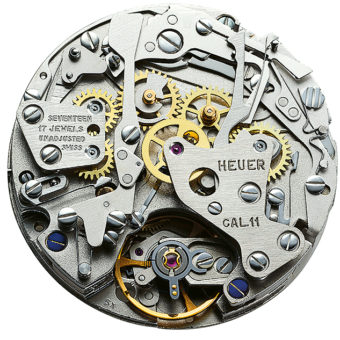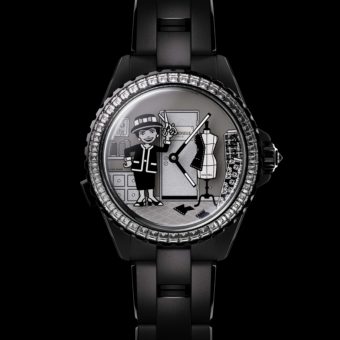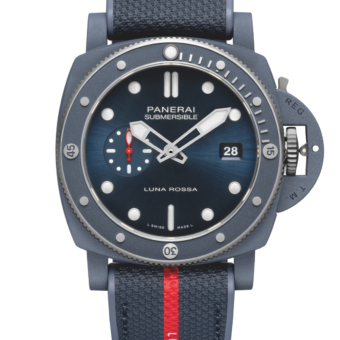Caliber P.2004 is a hand-wound chronograph with eight days of autonomous running and a column wheel to control its chronograph functions. This 8.2-mm caliber has 333 parts. Panerai uses a vertical coupling mechanism, i.e., a force-locking connection with two disks. One push-piece at 8 o’clock is responsible for the three chronograph functions (start, stop and return to zero). An innovative return-to-zero lever with sprung ends helps to reduce pressure on the bearings of the chronograph’s elapsed-seconds hand and on the bearings of the elapsed-minutes hand, which tallies intervals up to 30 minutes.

The fourth musketeer appeared in 2007, the hand-wound Caliber P.2005, which contains a very unconventional tourbillon and GMT function. The caliber does not contain a conventional rotating tourbillon cage to compensate for the effects of gravity when the watch is in a vertical orientation. Instead, Klein has come up with a cage that rotates on an axis parallel to the base of the movement at right angles to the axis of oscillation of the balance. What’s more, the cage makes two revolutions per minute, as opposed to the one per minute of most other tourbillons, so friction is minimized in the bearings of the balance arbor, pallet lever and escape wheel. Klein calls his construction “a chicken on a rotisserie.” It is made possible by the comparatively small diameter of the balance and by the movement’s stately height of 9.1 millimeters. However, the rotisserie arrangement increases the diameter of the movement to a hefty 16½ lignes or 36.6 millimeters, like that of the current Unitas-based hand-wound Calibers OP X and XI. Propelling the series of gear trains saps plenty of energy, reducing the power reserve to six days, despite the presence of three barrels.


Panerai’s design is better at compensating for errors caused by changes in position, which are more numerous in a wristwatch than the pocket watches for which the tourbillon was originally invented. Klein is understandably proud: “My tourbillon ranks among the best inventions in mechanical timekeeping. And it can be produced without major problems thanks to our ultramodern facility at Valfleurier.” But like all good things, making it takes plenty of precious time: aficionados who want to own a wristwatch containing Caliber P.2005 must be patient, as the waiting period can be several years. To these four movements, Panerai has this year added four more. The new P.2006 caliber introduced in January is the latest and most sophisticated version of the P.2004. It is a hand-wound, split-seconds chronograph movement with double column wheel that, in addition to the push-piece at 8 o’clock to regulate the start/stop/reset functions, has another push-piece at 10 o’clock to start the split-second function. The movement has 356 components, three barrels providing eight days of power, and a frequency of 28,800 vph. It is used in the new Luminor 8 Days Rattrapante watch with a 47-mm-diameter rose-gold case, two counters, and a linear power-reserve indicator.







PAM233 original dot dial with the 8 day power reserve manual wind movement is the best for me.
Sorry, cant get to like the end look as unique and value for money
pam 320
PAM 320 for me!